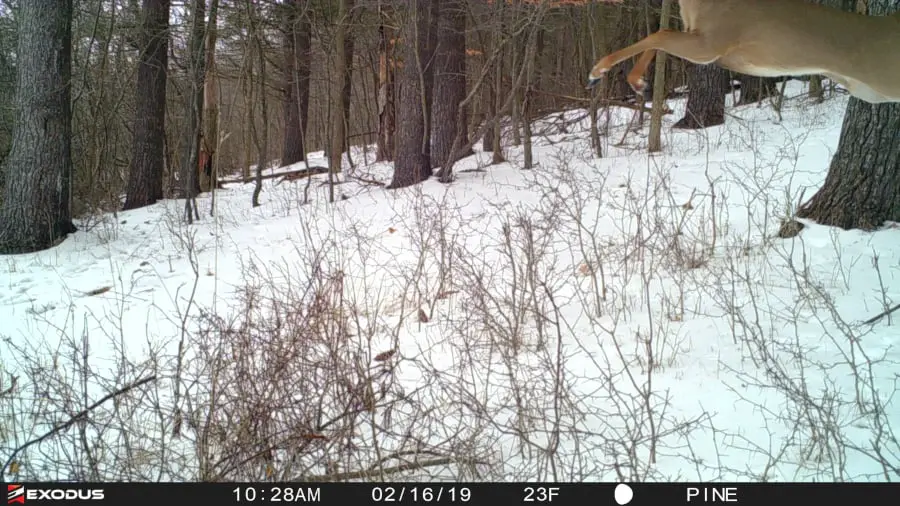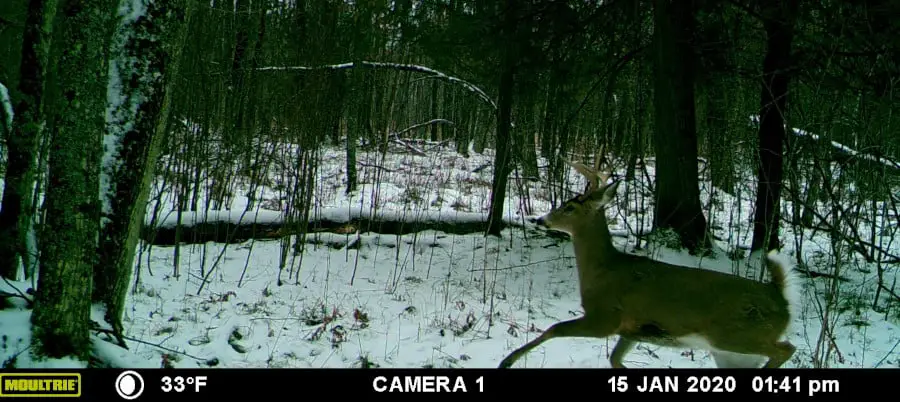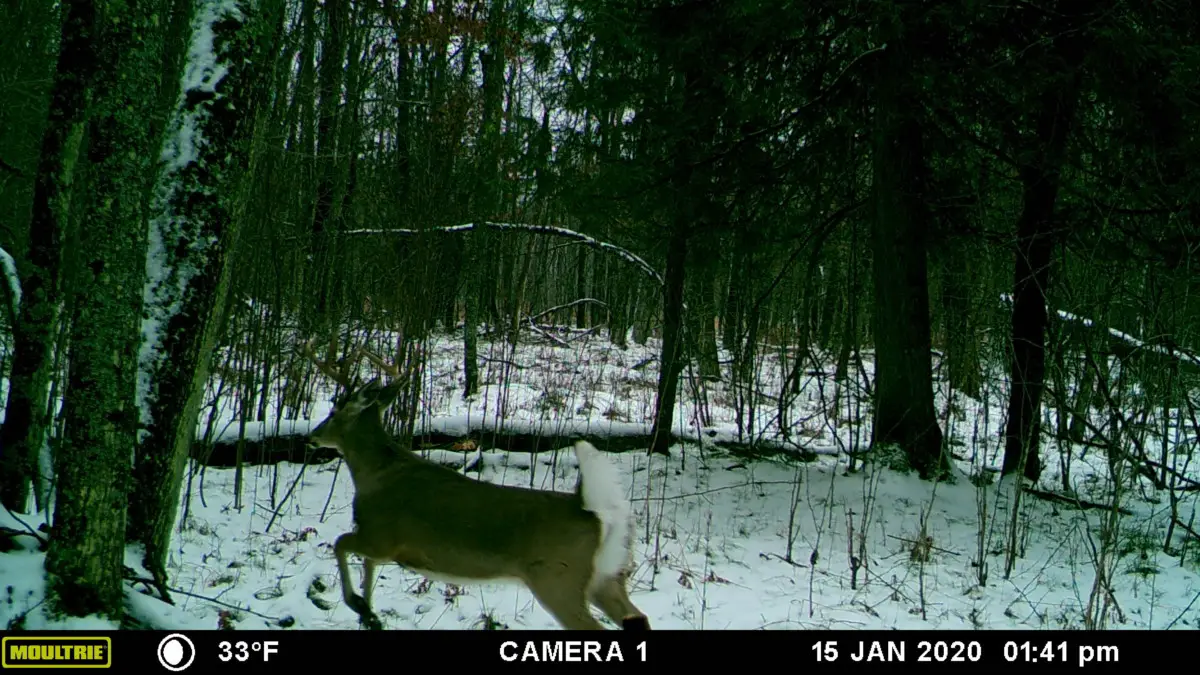Next to Megapixels, trigger speed is one of the most widely marketed specs from trail camera manufacturers. Using terms like “blazing trigger speed” or “lightening fast trigger,” it promotes an unconscious desire for the consumer to want a fast trigger speed.
Does the trigger speed mean a better quality trail camera? Will it take better photos? And most importantly, Will it cut down on the amount of motion blur? Before we answer these questions, it is important to understand what a trigger speed is.
A trail camera’s trigger speed is measured by the amount of time it takes for a trail camera to take a photo once an animal moves into the detection zone. The average trigger speed for a trail camera is .47 seconds.
How a Trail Camera Trigger Speed Works

When it comes to trigger speed there is a long list of steps that a trail camera must perform in order to take a photo. We have a great resource that goes in depth on how a trail camera works, but for now we will touch on just the main steps in trigger speed.
Here is a quick breakdown of the steps a trail camera takes when measuring trigger speed:
- PIR Sensor detects an animal
- The Light meter relays available light to the Exposure table
- The exposure table changes settings on the camera
- If there is inadequate light the camera enacts the flash and drops an infrared filter in front of the lens
- The shutter opens and closes
- The image sensor obtains the image
When an animal walks into the detection zone of a trail camera, the Passive Infrared sensor (PIR) detects a differential of infrared in the zone, and thus starts the process of taking a photo.
Once the PIR sensor detects the differential of infrared, the light meter on the camera relays the amount of available light to exposure tables on the back end of the camera. The exposure tables are pre written tables that takes into account the amount of light, and changes the most important aspects of photography, the shutter speed, and the ISO.
If there is not enough light in the surrounding area, the exposure tables enacts the artificial lights (flash) and drops an IR filter in front of the lens of the camera.
Once this is all completed, the shutter on the camera will open then close, exposing the image sensor to the area, in order for it to absorb the light and photo in front of the camera. Once the photo is obtained by the image sensor, the photo, and the official calculation of the trigger speed is complete.
To put it in perspective, all of these steps are done in just tenths of a second.
What The Trigger Speed Does

Now that we know how the trigger speed of a trail camera is measured, and all of the steps that are involved in the measurement of trigger speed, we need to explore what trigger speed actually does for the trail camera.
The trigger speed does NOT:
- Help with photo quality
- Stop Motion blur, this is done with the shutter speed
- Stop false triggers
The trigger speed’s only responsibility is to center the animal in the middle of the frame of the picture. That is it.
Looking at just the trigger speed of a camera, however does not tell the entire story of how it will perform. When you see the trigger speed, you also need to hold into account the Field of View and the Detection angle.
Field of View and Detection Angle
The field of view is the angle of the photo that the trail camera is taking. Depending on the trail camera, and the lens that that specific manufacturer uses, this angle can be from anywhere between 35-70 degrees.
The detection angle however is the angle from the trail camera that the PIR sensor covers. These angles range anywhere from 30-70 degrees as well.
The field of view and detection angle are very simple concepts to understand, but the important aspect of these two specifications is to match them to the trigger speed that the trail camera uses.
Fast Trigger Speeds
With a super fast trigger speed, you will want to make sure that the trail camera has a detection angle that is equal to or smaller than the field of view. The reason for this is that if you have a fast trigger speed and a detection angle that is larger than the field of view, the camera will detect an animal and take a photo before that animal gets into the field of view, thus taking a photo that will not have an animal in the photo.
When the Field of View and the Detection angle are similar angles, a fast trigger speed will be able to obtain the a photo with the animal in the picture much easier. Even if the animal is walking or running, the the quick trigger will still be able to capture the animal.
Slow Trigger Speeds
Despite the poor reputation that a trail camera with a slow trigger speed might have, there are many situations with the right field of view and detection these are actually a better choice.
Trail cameras with slower trigger speed from .5 to 1.5 seconds are actually great options for trail cameras that are hung over scrapes, bait piles and mineral licks. In these areas you know that deer are going to come in at a slower pace, therefore the need for a fast trigger speed is negated.
With these slower triggered cameras, it is important that the detection zone is larger than the field of view. In these situations, an animal outside of the field of view will trigger the camera to take a photo, but having a slow trigger speed, will allow the animal time to move into the field of view.
Other Considerations
While having a trail camera with a slow trigger speed is limited in the ways that you are able to use it, don’t be discouraged. In situations like travel corridors, pinch points and saddles, where deer will likely move through an area quicker, you can still use a slower camera.
You simply just need to increase the angle in which the animal will be traveling through the detection zone. In doing this, you simply need to hang the camera on a 45 degree angle from the trail in which the deer will be using. In doing this it elongates the amount of time the deer will be in the detection zone, making it easier to capture fast moving animals.
Average Trigger Speed
We researched over 200 cameras from 15 of the industry’s leading manufacturers to better understand trigger speeds available on the market. Here are some of the highlights that we found:
- The average trail camera has a .47 second trigger speed
- The average Cellular trail camera has a trigger speed of .406 Seconds
- The average stand alone camera has a trigger speed of .496 Seconds
- There is no discernible correlation between price of the trail camera and the trigger speed
- The fastest camera on the market (based on manufacturer specs) is the Stealth G34MAX with a .02 second trigger speed.
- The slowest camera on the market (based on manufacturer specs) is the Wildgame Innovations 360 Cam with a 1.5 second trigger speed.
** Not every trail camera manufacturer measures their trigger speed the same way. Spypoint claims from their own blog, that the trigger speed is the amount of time it takes the camera to come out of “sleep mode” and be ready to take a photo. This is obviously a different measurement than what trigger speed truly is, so consider that when looking at these specs provided by the manufacturer.**
Average Trigger Speed by Manufacturer
| Manufacturer | Average Trigger Speed | Fastest Camera |
| Browning | .28 Seconds | Recon Force Edge (.2 sec) |
| Bushenell | .357 Seconds | Core DS No Glow (.2 sec) |
| Campark | .366 Seconds | T30 (.3 Sec) |
| Covert | .532 Seconds | NBF 30-B (.22 sec) |
| Cuddeback | .25 Seconds | Dual Flash (.25 sec) |
| Exodus | .433 Seconds | Lift 2 (.3 sec) |
| Moultrie | .54 Seconds | XA7000i (.3 sec) |
| Muddy | .966 Seconds | Pro Cam 20 (.6 sec) |
| Primos | .7 Seconds | Autopilot (.4 sec) |
| Reconyx | .430 Seconds | HL2X (.1 sec) |
| Snyper | .4 Seconds | Commander 4G (.4 sec) |
| Spartan | .6 Seconds | Go Cam (.6 sec) |
| Spypoint | .297 Seconds | Force Dark (.07 sec) |
| Stealth | .558 Seconds | G34Max (.02 sec) |
| Wildgame Innovations | .769 Seconds | Rival 20 (.5 sec) |
10 Fastest Cameras on the Market
| Manufacturer | Camera Model | Trigger Speed |
| Stealth | G34MAX | .02 Seconds |
| Spypoint | Force-Dark | .07 Seconds |
| Spypoint | Link Dark | .07 Seconds |
| Spypoint | Link S | .07 Seconds |
| Spypoint | Solar Dark | .07 Seconds |
| Reconyx | HL2X | .1 Seconds |
| Reconyx | HL2XC | .1 Seconds |
| Browning | Recon Force Advantage | .2 Seconds |
| Browning | Recon Force Edge | .2 Seconds |
| Browning | Spec Ops Advantage | .2 Seconds |
10 Slowest Cameras On the Market
| Manufacturer | Model | Trigger Speed |
| Wildgame Innocations | 360 Cam | 1.5 Seconds |
| Muddy | Pro Cam 16 | 1.5 Seconds |
| Stealth | PX24NG | 1.2 Seconds |
| Wildgame Innovations | Terra Extreme 10 | 1 Second |
| Stealth | Banshee | 1 Second |
| Reconyx | XR6 | 1 Second |
| Reconyx | XP9 | 1 Second |
| Reconyx | SX8 | 1 Second |
| Primos | Mug Shot | 1 Second |
| Bushnell | Impulse | 1 Second |
The Ideal Trigger Speed for a Trail Camera
In the trail camera industry there are literally thousands of trail cameras with a wide variety of trigger speeds, detection angles, and field of views, so what is the ideal setup for a trail camera. Obviously, there is a situation for every combination in the woods. I personally like a trail camera that has a trigger speed between .2 and .4 seconds, with a Field of View and a detection angle that are close to the same size.
Having this combination gives you a lot of versatility in the field and having that versatility is a great option to add to any trail camera arsenal.

